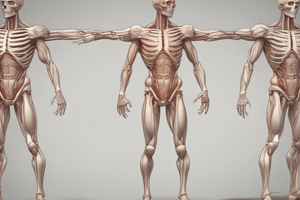Podcast
Questions and Answers
The gluteal region is a major transition zone between the trunk and upper extremity.
The gluteal region is a major transition zone between the trunk and upper extremity.
False (B)
What are the two ligaments discussed in association with the gluteal region?
What are the two ligaments discussed in association with the gluteal region?
Sacrotuberous and sacrospinous ligaments
The _______ nerve is a key feature of the gluteal region.
The _______ nerve is a key feature of the gluteal region.
sciatic
Match the following gluteal muscles with their functions:
Match the following gluteal muscles with their functions:
Which slide covers the topic of gluteal muscles?
Which slide covers the topic of gluteal muscles?
The cutaneous innervation of the posterior thigh is discussed on Slide 19.
The cutaneous innervation of the posterior thigh is discussed on Slide 19.
What is the primary blood supply for the gluteal region?
What is the primary blood supply for the gluteal region?
The _______ and _______ bursa are mentioned in relation to the hip joint.
The _______ and _______ bursa are mentioned in relation to the hip joint.
What condition related to the hip joint involves an abnormal growth pattern that can lead to joint problems?
What condition related to the hip joint involves an abnormal growth pattern that can lead to joint problems?
Flashcards are hidden until you start studying
Study Notes
Gluteal Region Overview
- Defined by boundaries: superiorly by iliac crest, medially by the natal cleft, and inferiorly by the gluteal sulcus.
- The gluteal fold is formed by the inferior border of the gluteus maximus muscle.
Gluteal Fascia
- Superficial fascia consists of typical fatty tissue, continuous with superficial fascia from abdomen and thigh.
- Deep fascia, known as gluteal fascia, is continuous with the fascia lata and encloses the gluteus maximus muscle.
- Gluteal fascia also covers the superficial surface of the gluteus medius muscle.
Sacrotuberous and Sacrospinous Ligaments
- Both ligaments extend from the sacrum to the hip bones, forming part of the lateral pelvic wall.
- Sacrotuberous ligament connects sacrum to ischial tuberosity.
- Sacrospinous ligament connects sacrum to ischial spine.
- Define the borders of the greater and lesser sciatic foramina, allowing structures to pass between the pelvis and lower extremity.
Gluteal Muscles
- Muscles are categorized into gluteal muscles and lateral hip rotators.
- Two additional nerves (pudendal and sciatic) traverse the gluteal region; pudendal nerve heads toward the perineum, while sciatic nerve serves the posterior thigh and leg.
Blood Supply to Gluteal Region
- Supplied by superior and inferior gluteal arteries, both branches of the internal iliac artery.
- Superior gluteal artery exits via the greater sciatic foramen above piriformis, supplying upper gluteal muscles and tensor fasciae latae.
- Inferior gluteal artery exits through the greater sciatic foramen below piriformis, supplying gluteus maximus and lateral rotators, as well as parts of the posterior thigh muscles.
- Internal pudendal artery exits inferior to piriformis, rounding around ischial spine, and entering the perineum through the lesser sciatic foramen without branches in the gluteal region.
Gluteal Intramuscular Injections
- Commonly performed in the gluteal region for drug administration.
- Due to underlying neurovascular structures, injections should be conducted in a "safe area," marked by an imaginary line from the posterior superior iliac spine to the greater trochanter.
Gluteal Region Significance
- Acts as a transition zone between the trunk and lower extremity, playing a crucial role in movement and support.
- Knowledge of anatomy crucial for clinical procedures and understanding potential injuries or complications.
Studying That Suits You
Use AI to generate personalized quizzes and flashcards to suit your learning preferences.



